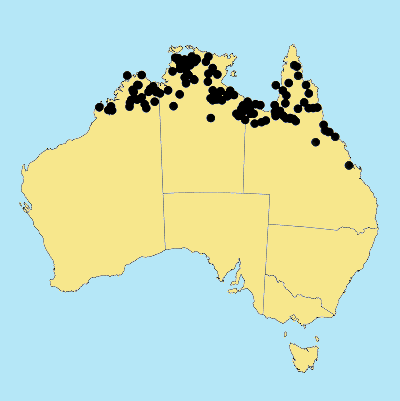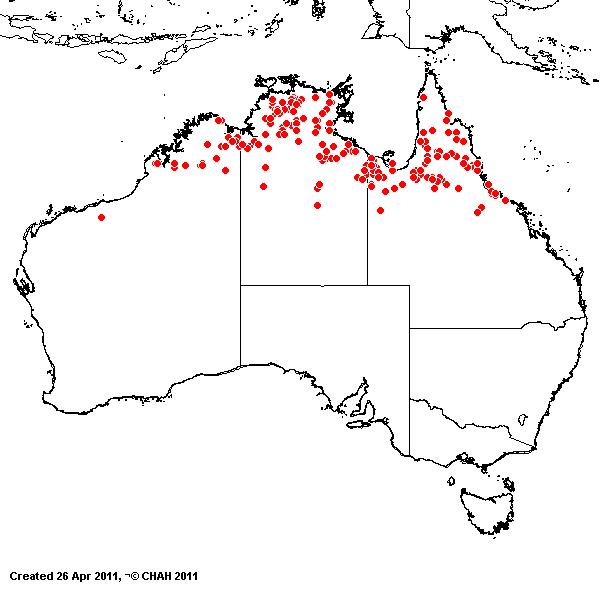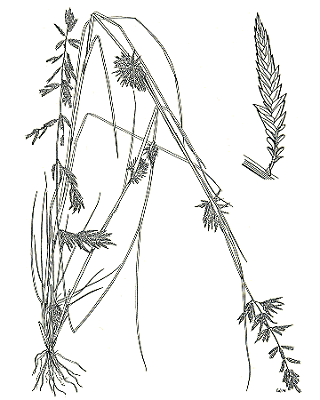Eragrostis fallax M. Lazarides. Aust.
Syst. Bot. 10: 120 (1997).
Classification. (GPWG 2001) : Subfamily
Chloridoideae. Cynodonteae.
Type of Basionym or
Protologue Information: Australia,
Barkly Tableland: Kanis 1817
(CANB holo, K, L, NT, US).
Key references
(books and floras): [2002] D.Sharp & B.K.Simon, AusGrass, Grasses of
Australia.
Illustrations:
[2005] K.Mallet (ed.), Flora of Australia 44B: Poaceae 3
(Fig. 69A-B).
Habit.
Perennial. Culms erect, 40–90 cm tall, 3–6 -noded. Lateral branches simple.
Leaf-sheaths smooth, glabrous on surface. Ligule a fringe of hairs, 0.2–0.3 mm
long. Leaf-blades straight, flat or convolute, 15–30 cm long, 2–5 mm wide.
Leaf-blade surface scabrous, glabrous.
Inflorescence.
Inflorescence compound, a panicle or a panicle. Panicle elliptic, dense or
loose, 10–20 cm long, 4–6 cm wide.
Spikelets.
Spikelets sessile or pedicelled. Fertile spikelets many flowered, with at least
2 fertile florets (11–56), comprising 11–56 fertile floret(s), with diminished
florets at the apex, linear or lanceolate, laterally compressed, 10–33 mm long.
Glumes. Glumes
similar. Lower glume lanceolate or ovate, membranous or cartilaginous, without
keels or keeled, 1-keeled, 0–1 -nerved. Upper glume lanceolate or ovate,
1.8–2.6 mm long, membranous or cartilaginous, keeled, 1-keeled, 1 -nerved.
Florets. Fertile
lemma 2.3–3.3 mm long, keeled, 3(–5) -nerved. Lemma apex muticous or mucronate.
Palea 2 -nerved. Anthers 3. Grain 0.4–0.6 mm long.
Continental
Distribution: Australasia.
Australian
Distribution: Western Australia, Northern Territory, Queensland.
Western
Australia: Gardner.
Northern Territory: Darwin & Gulf, Victoria
River, Barkly Tableland. Queensland:
Burke, Cook, North Kennedy.
Notes.
Distinguishing characters include robust tussocky habit; chasmogamous and
cleistogamous spikelets; semi-persistent thickened zig-zag rachilla; unequal
glumes, the lower often nerveless and rounded on the back; short paleas
relative to lemmas; with closely scaberlous keels, and distinctly narrow flaps.
Often, axillary clusters of spikelets are present especially near the base of
the plant.
Endemic;
widespread across tropical Australia
from Broome in W.A. to coastal Qld. as far S as about Mackay. In or near
seasonally flooded sites (lagoons, swamps, floodplains, streams, valley floors)
in alluvial clay or sandy soils and associated with granite, sandstone,
laterite or limestone.; flowers all year round.; fruits all year round.



